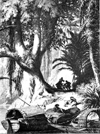| Meeting 4 • 19 January 2012 • Thursday |
Version: |
|
picture of the week |
thought-bite of the week: |
|
"I reckoned that it was my duty… to record all the data obtained from reliable sources.… The further man is from civilization, the more he enjoys astonishing people…. He says he has seen what he imagines may have been seen by others." |
|
|
mini-text of the week (start): "At midday we stopped at a deserted spot called Algodonal.… I walked along the beach to observe a group of crocodiles asleep in the sun.… [M]y stroll almost cost me my life.… " Humboldt, "Personal Narrative", from Jaguars and Electric Eels, ed. & trans. Wilson, p. 74 (read more) |
|
|
<< Humboldt's canoe (source: Botting, Humboldt and the Cosmos, p. 103 [0027]) |
Materials: ••
|
(X') = anticipated time in minutes (total=75) |
(0001) etc.=item in Humboldt Project document collection |
|
Key to notes added AFTER the class meets: |
|
|
√ = topic / activity that was adequately dealt with during the class |
+ = topic that was started but needs more attention & will be resumed at next / subsequent meeting(s) |
|
- = a topic / activity that was proposed though not begun, but will be taken up later |
|
|
Italic bold green text like this = comments after the meeting |
|
|
√ |
(5') Mini-text of the week: Our own fearful encounters with fearsome, ferocious creatures Bears were the most commonly encountered scary creatures. |
|
+ |
(30') Speaking of fear: The quantitative ingredient of this course. English vs. metric; using our hands and feet to fathom the world (daycare center: "How big is [child]?"; telluric vs. planetary views / consciousness; moving over the surface of the world vs. looking at the Earth from space So let's do a warmup before (next week) we SINQ the Humboldt Canoe quantatitively: Small groups (4-8): Generate (without using outside sources) the collective sense for these everyday quantities, which can then be used to do much more quantitatively (basic quantities worksheet, stage 1). Report and compare the groups' quantities. Now go back into groups to use your quantities to determine these quantities (basic quantities worksheet, stage 1), which are examples of quantities Humboldt needed to work with constantly. Report and compare in plenary group. Next meeting you'll apply your quantities to determine some real-world (sometimes life-or-death) quantities needed by people who had to get across and around the globe in earlier times, and also some quantities that we encounter in discussions of sustainability. |
|
√ |
(5') Humboldt's travel routes through the "New World": route on the Orinoco and Amazon Rivers (0036); along and atop the Andes (0037); through Mexico (0038); . While you look at the map, think about the distances and what it meant to cover them on foot/ horseback / water. |
|
√ |
(5')Where are we on our course title? We've got AvH into exploring, but not into sustainable environmentalism. |
|
+ |
|
|
+ |
(5') Importance of teamwork and, whether during group or individual work, recognizing and then bringing forth your individual experiences and skills. Short example: You think you may have taken a course that relates to our course. Find someone else who has taken that or a similar course; report back. |
|
√ |
(5') So what was I doing in Hawaii? Link to Lyon Arboretum; Arboretum Center & panorama; a threatened plant (plant; signage); professor as Humboldt in Lyon Arboretum; a Hawaiian canoe; history of Bible in Hawaiian; sea asparagus and sustainable agriculture; upcoming activity: portraits of ourselves as environmentalist-explorers |
|
|
